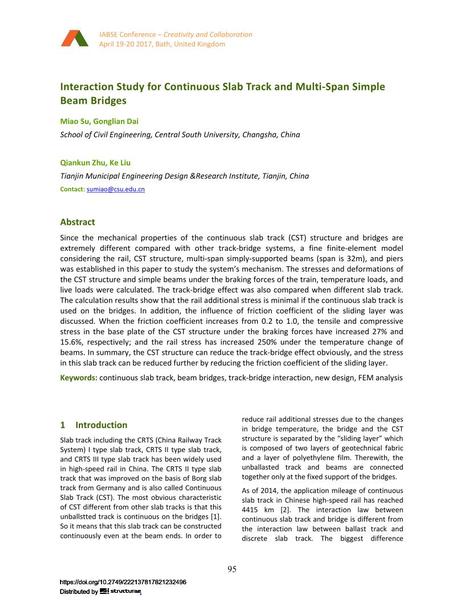Interaction Study for Continuous Slab Track and Multi-Span Simple Beam Bridges

|
|
|||||||||||
Bibliographic Details
| Author(s): |
Miao Su
Gonglian Dai Qiankun Zhu Ke Liu |
||||
|---|---|---|---|---|---|
| Medium: | conference paper | ||||
| Language(s): | English | ||||
| Conference: | IABSE Conference: Creativity and Collaboration – Instilling Imagination and Innovation in Structural Design, Bath, United Kingdom, 19-20 April 2017 | ||||
| Published in: | IABSE Conference Bath, April 19-20, 2017 | ||||
|
|||||
| Page(s): | 95-100 | ||||
| Total no. of pages: | 6 | ||||
| Year: | 2017 | ||||
| DOI: | 10.2749/222137817821232496 | ||||
| Abstract: |
Since the mechanical properties of the continuous slab track (CST) structure and bridges are extremely different compared with other track-bridge systems, a fine finite-element model considering the rail, CST structure, multi-span simply-supported beams (span is 32m), and piers was established in this paper to study the system’s mechanism. The stresses and deformations of the CST structure and simple beams under the braking forces of the train, temperature loads, and live loads were calculated. The track-bridge effect was also compared when different slab track. The calculation results show that the rail additional stress is minimal if the continuous slab track is used on the bridges. In addition, the influence of friction coefficient of the sliding layer was discussed. When the friction coefficient increases from 0.2 to 1.0, the tensile and compressive stress in the base plate of the CST structure under the braking forces have increased 27% and 15.6%, respectively; and the rail stress has increased 250% under the temperature change of beams. In summary, the CST structure can reduce the track-bridge effect obviously, and the stress in this slab track can be reduced further by reducing the friction coefficient of the sliding layer. |
||||
| Keywords: |
track-bridge interaction FEM analysis beam bridges continuous slab track new design
|
||||
